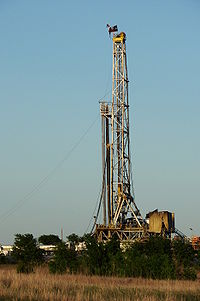
Photo from wikipedia
Abstract To have a better understanding of initiation and propagation of hydraulic fracture in transversely isotropic reservoir, a bonded-particle model (BPM) coupling fluid-mechanical was carried out to investigate the fracture… Click to show full abstract
Abstract To have a better understanding of initiation and propagation of hydraulic fracture in transversely isotropic reservoir, a bonded-particle model (BPM) coupling fluid-mechanical was carried out to investigate the fracture networks in tight sandstone with different dip angles. Acoustic emission technique is applied in hydraulic fracturing modeling to monitor crack initiation and propagation. The results indicate that the complex fracture network is more prone to form under low differential stress. The magnitude of AE events of the hydraulic fracture along the bedding planes is lower, compared to those propagating at the angle with respect to the direction of the bedding plane. The interaction mode between the hydraulic fracture and bedding planes can be categorized into 4 types: (1) fracture network (location at the borehole) + multi-branch fractures; (2) fracture network (location at the vicinity of the hydraulic fractures) + multi-branch fractures; (3) multi-branch fractures; (4) a single fracture.
Journal Title: Journal of Structural Geology
Year Published: 2020
Link to full text (if available)
Share on Social Media: Sign Up to like & get
recommendations!